



T-AKR USNS Bob Hope
Large, Medium-speed, roll-on/roll-off ships [LMSR]
Military Sealift Command's newest class of ships � Large, Medium-speed, Roll-on/Roll-off Ships, or LMSR � will significantly expand the nation's sealift capability in the 1990s and beyond. Nineteen LMSRs will have been converted or built at U.S. shipyards by the year 2001. The LMSRs will provide afloat prepositioning of an Army heavy brigade�s equipment and a corps� combat support, as well as surge capability for lift of a heavy division�s equipment from the United States.
The need for additional military sealift ships was identified in a Congressionally-mandated study by the Joint Chiefs of Staff in the early 1990s. The Mobility Requirements Study focused on Department of Defense transportation during the Persian Gulf War. It highlighted the urgent need for greater sealift capacity to transport military equipment and supplies during wartime and other national contingencies. In response to the sealift shortfall, an ambitious Strategic Sealift Acquisition Program was introduced. Plans called for adding 19 LMSRs which will provide five million square feet of capacity early in the next century.
The LMSR program currently has 19 ships, 5 of which will be conversions of existing commercial container vessels to replace the existing fleet of seven RO/ROs , and 14 of which will be newly constructed ships. In FY 98, three newly constructed LMSRs joined the fleet, followed by four more in FY 99-02. At that time, the five converted LMSRs will be removed from service. All 19 ships use common cargo handling systems, procured by the Navy. LMSRs are being built by three contractors. A performance type procurement description was used, therefore specific ship configurations differ as the respective builders interpret the mission requirements.
LMSRs can carry an entire U.S. Army Task Force, including 58 tanks, 48 other track vehicles, plus more than 900 trucks and other wheeled vehicles. The ship carries vehicles and equipment to support humanitarian missions, as well as combat missions. The new construction vessels have a cargo carrying capacity of more than 380,000 square feet, equivalent to almost eight football fields. In addition, LMSRs have a slewing stern ramp and a removable ramp which services two side ports making it easy to drive vehicles on and off the ship. Interior ramps between decks ease traffic flow once cargo is loaded aboard ship. Two 110-ton single pedestal twin cranes make it possible to load and unload cargo where shoreside infrastructure is limited or nonexistent. A commercial helicopter deck was added for emergency, daytime landing.
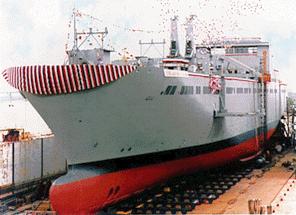 The LMSR ships are Large (950 feet long, 106 feet wide, 55,000 long ton displacement), Medium Speed (24 knots), Roll-on/Roll-off (RO/RO) vessels. The sealift ships will be capable of self-sustained RO/RO and Lift on/Lift off (LO/LO) operations at a pier and in a Logistics-Over-the Shore (LOTS) scenario through stern and side port ramps to a RO/RO Discharge Facility (RRDF). In addition, the LMSR will be capable of self-sustained LO/LO cargo operations in a LOTS scenario by interfacing with lighterage. The LMSR ships are not armed, and do not have a combat system. They do have C3I suite sufficient to perform their intended mission in conjunction with other Naval vessels.
The LMSR ships are Large (950 feet long, 106 feet wide, 55,000 long ton displacement), Medium Speed (24 knots), Roll-on/Roll-off (RO/RO) vessels. The sealift ships will be capable of self-sustained RO/RO and Lift on/Lift off (LO/LO) operations at a pier and in a Logistics-Over-the Shore (LOTS) scenario through stern and side port ramps to a RO/RO Discharge Facility (RRDF). In addition, the LMSR will be capable of self-sustained LO/LO cargo operations in a LOTS scenario by interfacing with lighterage. The LMSR ships are not armed, and do not have a combat system. They do have C3I suite sufficient to perform their intended mission in conjunction with other Naval vessels.
Christening ceremonies for the Navy's new Military Sealift Command (MSC) ship took place 15 March 1997 at Avondale Shipyards in New Orleans. The ship was named Bob Hope (T-AKR 300) in honor of the veteran entertainer's decades of devoted service to US military men and women around the world. Bob Hope is the first of 14 large, medium-speed, roll-on, roll-off ships constructed from the keel up for the Military Sealift Command. Bob Hope joined MSC's Afloat Pre-positioning Force in 1998.
USNS Bob Hope is the lead ship in the new Bob Hope class of sealift ships being built by Avondale Industries. The contract for the lead ship was awarded in September 1993 and called for one ship at a cost of $265 million and included options for up to five additional ships at a total cost of $1.3 billion. On 27 May 1997 Avondale Industries
announced that it was awarded a new option for the construction of the seventh ship in the Bob Hope class. The option has a value of $228.2 million upon its exercise which is anticipated in 1999. After consideration of certain additional components and cost escalations, the option when exercised is expected to total more than $250 million. Avondale's peak production on the Sealift vessels is anticipated to involve the direct employment by the company of approximately 3,000 individuals.
In addition to the Bob Hope class ships, contracts for other sealift ships have been awarded in 1993 including a $1.3 billion contract to the National Steel and Shipbuilding Company (NASSCO) for one new construction ship plus an option for up to five additional ships, a $426 million contract to Newport News Shipyard for two converted ships and a $635 million contract to NASSCO for three converted ships. On 28 May 1997 National Steel and Shipbuilding Company (NASSCO) received a $227 million Navy contract to build a sixth strategic Sealift ship. And on 14 November 1997 NASSCO announced that the company had been awarded a $195 million contract for the construction of the seventh Strategic Sealift Ship.
Initially it appeared that a total of 14 ships of this class would be constructed, equally divided between NASSCO and Avondale. However, the class will now apparently consist of at least 15 ships, with the addition of TAKR 317, to be delivered in October 2002. The Soderman was originally converted by NASSCO from a commercial containership to a large, medium-speed, roll-on/roll-off (LMSR) vessel and delivered to the Navy in November 1997. Funding for construction of a new LMSR to replace the Soderman in the Navy's combat prepositioning squadron of LMSRs was included in the FY-2001 Defense Appropriations bill approved by Congress in October 1999.
The US Navy's Military Sealift Command ship USNS Bob Hope completed its Balkan operation in early July 1999, moving heavy combat equipment and supplies to U.S. peacekeeping forces in Kosovo. Following Joint Guardian operations, Bob Hope was loaded with Army combat equipment and prepositioned off Diego Garcia in the Indian Ocean.
Specifications
|
|
|
| General Characteristics | Bob Hope Class | Watson Class
|
| Builder | Avondale Industries | National Steel and Shipbuilding
|
| Power Plant | 4 Colt Pielstick 10 PC4.2 V diesels;
65,160 hp(m) (47.89 MW) | 2 GE Marine LM gas turbines;
64,000 hp (7.7 MW);
2 shafts, cp props
|
| Length | 951.4 feet (290 meters)
|
| Beam | 106 feet (32.3 meters)
|
| Displacement | 62,069 tons full load
(63,055.9 long tons) | 62,968 tons full load
(63,969.2 long tons)
|
| Cargo capacity | 380,000 sq. ft. | 393,000 sq. ft.
|
| Speed | 24 knots (27.6 mph)
|
| Crew | 26 civilian crew (up to 45);
up to 50 active duty
|

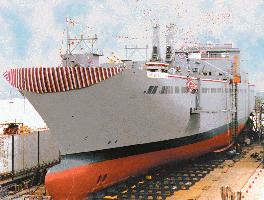
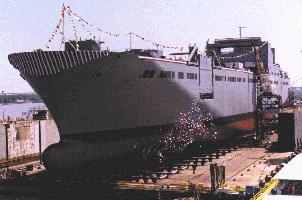
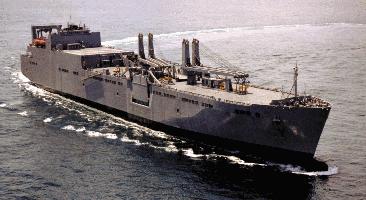
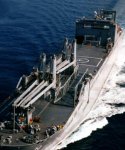
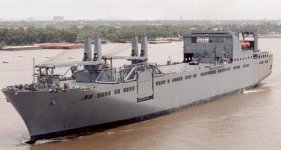
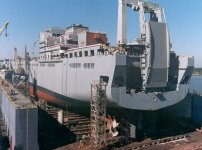
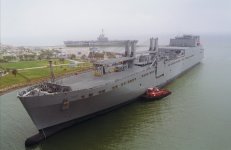
Sources and Resources
- Strategic Sealift Ship; T-AKR 300 @ Avondale
- STRATEGIC SEALIFT SHIPS (NEW CONSTRUCTION) @ NASSCO
- Navy Christens Newest Cargo Ship USNS Brittin (T-AKR 305), U.S. Department of Defense, 19 October 2000 -- The Navy will christen its newest roll-on/roll-off cargo ship USNS Brittin (T-AKR 305) at Litton-Avondale Shipyard in New Orleans, La., at 10 a.m., Saturday, Oct. 21.
- NASSCO Delivers the USNS CHARLTON May 23, 2000 -- SAN DIEGO, CA -- National Steel and Shipbuilding Company (NASSCO), a wholly owned subsidiary of General Dynamics (NYSE: GD), has delivered the USNS CHARLTON (T-AKR 314) to the U.S. Navy. The CHARLTON is the fifth new construction ship built by NASSCO under the U.S. Navy's Strategic Sealift Program.
- NASSCO Awarded $230 Million Contract for Eighth New Construction Strategic Sealift Ship February 25, 2000 -- National Steel and Shipbuilding Company (NASSCO), a General Dynamics company (NYSE: GD), has been awarded a $230 million contract to build its eighth Large Medium Speed Roll-on/Roll-off (LMSR) ship under the U.S. Navy's Strategic Sealift Program.
- Landing the Kosovo Force by John R. Randt Army Logistician JANUARY-FEBRUARY 2000 -- The Bob Hope arrived in Thessaloniki on 29 June, 6 days after departing Bremerhaven. The Bob Hope completed discharge of its cargo on 1 July. The Soderman arrived 3 July, and its unloading began at once. Later, the contract vessel Osprey arrived from Beaumont, Texas, with equipment from several continental United States (CONUS) Army installations to augment the task force.
- NASSCO Delivers the USNS RED CLOUD January 19, 2000 -- National Steel and Shipbuilding Company (NASSCO), a General Dynamics company (NYSE: GD), has delivered the USNS RED CLOUD (T-AKR 313) to the U.S. Navy.
- Navy ship named for Army MOH winner (Army News Service, January 19, 2000) - The fifth in a series of seven Strategic Sealift ships being built by Litton Avondale Industries, T-AKR 304, was christened PILILAAU in ceremonies at the New Orleans shipyard January 8.
- NAVY CHRISTENS NEWEST ROLL-ON/ROLL-OFF CARGO SHIP USNS CHARLTON December 8, 1999 - The U.S. Navy will christen its newest roll-on/roll-off cargo ship USNS CHARLTON (T-AKR 314) during a ceremony at 9:30 a.m. PST, Saturday, Dec. 11, 1999, at National Steel and Shipbuilding, San Diego, Calif.
- U.S. Navy christens roll-on/roll-off cargo ship USNS Red Cloud DoD Public Affairs 07 August 1999 -- The U.S. Navy christened its newest roll-on/roll-off cargo ship, USNS Red Cloud (T-AKR 313), on Aug. 7 at National Steel and Shipbuilding Company in San Diego, Calif.
- NASSCO Delivers the USNS DAHL, Its Third Sealift New Construction Ship July 13, 1999 -- SAN DIEGO, CA -- National Steel and Shipbuilding Company (NASSCO) today delivered the USNS DAHL to the U.S. Navy. The USNS DAHL (T-AKR 312) is the third Sealift New Construction ship built by NASSCO under the Strategic Sealift Program and the third ship to be completed under target cost and delivered to the Navy ahead of schedule.
- Navy christens USNS Mendonca DOD Public Affairs Navnews 14 April 1999 -- The U.S. Navy christened its newest
roll-on/roll-off cargo ship USNS Mendonca (T-AKR 303) April 10 at Avondale Industries Inc., in New Orleans.
- SECRETARY OF THE NAVY ASSIGNS NEW SHIP NAMES October 6, 1998 - Secretary of the Navy John H. Dalton has announced his decision to assign names to 13 new Navy ships.
- MSC christens LMSR in San Diego NAVY WIRE SERVICE 02 October 1998 -- Military Sealift Command christened USNS Dahl Oct. 2 at the National Steel and Shipbuilding Company in San Diego.
- NASSCO Delivers the USNS SISLER, Its Second Sealift New Construction Ship, Ahead of Schedule and Under Target Cost October 2, 1998 -- San Diego, California. National Steel and Shipbuilding Company (NASSCO) today reported that it has delivered the USNS SISLER to the U.S. Navy. Originally contracted to be delivered in May 1999, the ship was completed under target cost and accepted by the Navy six months ahead of schedule.
- USNS DAHL (T-AKR 312) NAMED AFTER MEDAL OF HONOR RECIPIENT October 1, 1998
- MSC to christen sixth LMSR in San Diego Military Sealift Command Newsrelease 29 Sep 1998 -- Military Sealift Command will christen USNS Dahl, its sixth new construction large, medium-speed, roll-on/roll-off ship, in a ceremony Oct. 2 at the National Steel and Shipbuilding Company in San Diego.
- New Navy ship honors Army hero Military Sealift Command Newsrelease 10 Jul 1998 -- USNS Seay (T-AKR 302) was christened June 20 in New Orleans. USNS Seay is the third of the seven large, medium-speed, roll-on/roll-off ships being built by Avondale.
- MSC takes delivery of USNS Watson Military Sealift Command Newsrelease 30 Jun 1998 -- Military Sealift Command took delivery of USNS Watson, the first of 14 new construction large, medium-speed, roll-on/roll-off ships, called LMSRs, in late June.
- NAVY CHRISTENS NEWEST ROLL-ON/ROLL-OFF CARGO SHIP USNS MENDONCA (T-AKR 303) April 9, 1998
- Sisler christened in San Diego ceremony Military Sealift Command Newsrelease 04 Mar 1998 -- USNS Sisler (T-AKR 311), the fourth of 14 new large, medium-speed, roll-on/roll-off ships destined for the U.S. Navy's Military Sealift Command operation, was christened Feb. 28 at the National Steel and Shipbuilding Company.
- MSC tries new contracting approach
Military Sealift Command Newsrelease 31 Jul 1997 -- Military Sealift Command awarded a $91 million contract to Maersk Line Limited in Norfolk, Va., for the operation and maintenance of eight large, medium-speed, roll-on/roll-off sealift ships, all newly constructed U.S. military cargo ships which will begin operation in 1998.
- Military Sealift Command's second new LMSR is christened Military Sealift Command Newsrelease 28 Jul 1997 -- Large, medium-speed, roll-on/roll-off ship USNS Watson (T-AKR 310) was christened July 26 at National Steel and Shipbuilding Company.
- USNS Bob Hope will be the lead ship in the new Bob Hope
class of sealift ships MEMORANDUM FOR CORRESPONDENTS No. 021-M -- January 27, 1994
http://www.fas.org/man/dod-101/sys/ship/takr-300.htm
Maintained by Robert Sherman
Originally created by John Pike
Updated Saturday, October 14, 2000 7:12:24 AM
 The LMSR ships are Large (950 feet long, 106 feet wide, 55,000 long ton displacement), Medium Speed (24 knots), Roll-on/Roll-off (RO/RO) vessels. The sealift ships will be capable of self-sustained RO/RO and Lift on/Lift off (LO/LO) operations at a pier and in a Logistics-Over-the Shore (LOTS) scenario through stern and side port ramps to a RO/RO Discharge Facility (RRDF). In addition, the LMSR will be capable of self-sustained LO/LO cargo operations in a LOTS scenario by interfacing with lighterage. The LMSR ships are not armed, and do not have a combat system. They do have C3I suite sufficient to perform their intended mission in conjunction with other Naval vessels.
The LMSR ships are Large (950 feet long, 106 feet wide, 55,000 long ton displacement), Medium Speed (24 knots), Roll-on/Roll-off (RO/RO) vessels. The sealift ships will be capable of self-sustained RO/RO and Lift on/Lift off (LO/LO) operations at a pier and in a Logistics-Over-the Shore (LOTS) scenario through stern and side port ramps to a RO/RO Discharge Facility (RRDF). In addition, the LMSR will be capable of self-sustained LO/LO cargo operations in a LOTS scenario by interfacing with lighterage. The LMSR ships are not armed, and do not have a combat system. They do have C3I suite sufficient to perform their intended mission in conjunction with other Naval vessels.











